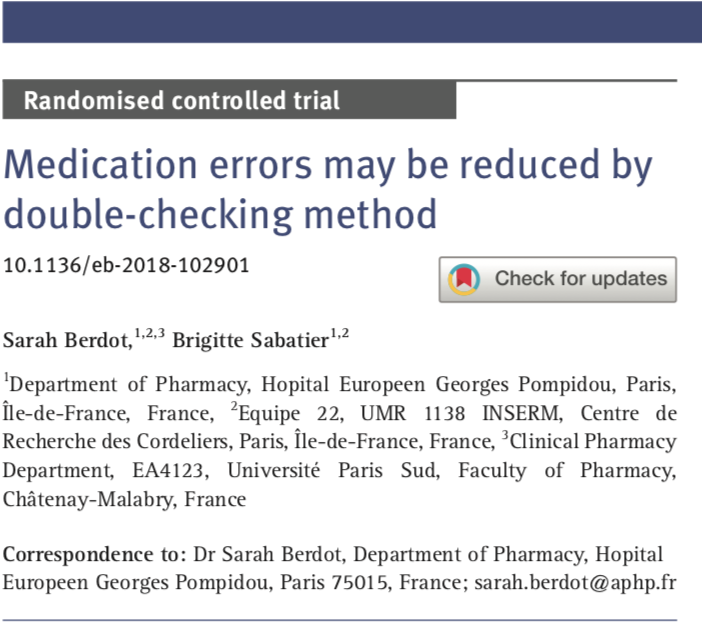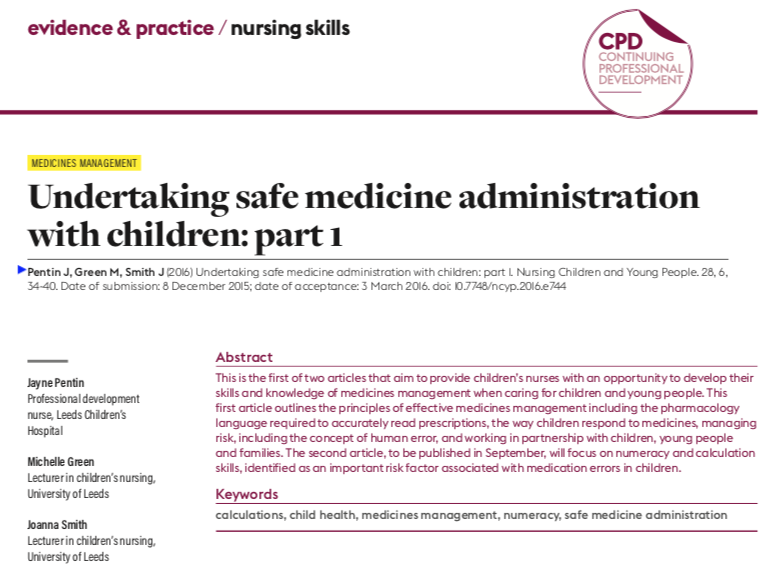Jayne Pentin, Professional Development Nurse Leeds Children’s Hospital
Dr Joanna Smith, Associate Professor, Child Nursing, University of Leeds
The UK Nursing Midwifery Council (NMC) standards for nursing include ensuring patients are safe (NMC, 2015), with the 2010 guidance on preparing and administering medicines, remaining unchanged (NMC, 2010). Although the role of the nurse in relation to medicines management has changed over the past decade to include independent prescribing, nurses are primarily responsible for preparing and administering medicines to their patients. Medicines errors can occur at any stage of the process of administering medicines from prescribing, dispensing, preparation and administering medicines and monitoring their effects, and therefore is a multi-disciplinary activity (Pentin et al., 2016). As the last person in the chain, nurses have a central role in identifying and preventing actual and potential medication errors.
The double-checking of medicines where two nurses are responsible for the safe administration of the medicine is often a local requirement but remains contentious. A recent EBN commentary:
Medication errors may be reduced by double-checking method by Berdot and Sabatier (2018), https://ebn.bmj.com/content/21/3/67 summarized and reviewed arandomized controlled trial on the effect of a double checking on detecting medication errors(Douglass et al.,2018).
The commentary highlighted that the study could not determine the effectiveness of double-checking in relation to reducing the risk of medication errors. While, the original study adds to an increasing evidence base relating to medication errors, the study was underpowered and the two groups were not comparable, but did raise some pertinent issues relating to the cost and effectiveness of double-checking in reducing medicine errors. What is not clear in the commentary is whether the double-checking procedure involves the patient or just the medication: this has potential legal concerns if local policy fails to define explicitly what the double-checking procedure involves. If a nurse gives medication to the wrong patient because they fail to positively identify the patient, the responsibility and accountability of the nurse who double-checked the medicine can be unclear. Two recent systematic reviews exploring the reasons for medication errors suggested errors broadly relate to human factors (unsafe acts such as the misidentification of medication, lack of patient knowledge), local workforce factors (poor communication, distractions and interruptions, workplace dynamics, inadequate medicines supply and storage), and organisational factors (poorly designed protocols and systems for managing errors) (Keers 2013a, b). Double-checking is unlikely to address many of these factors and more evidence is required in relation to whether double-checking can reduce human factors associated with medications errors.
There may be some value in exploring whether the introduction of electronic medicines has any impact in reducing medication error rates or if indeed has introduced new types of errors. Whilst the process of prescribing checking and administering medications is the same as with paper prescriptions, electronic medicines does reduce some potential errors such as misreading poor handwriting, lost or duplicated drug charts, and past prescriptions can be viewed easily. As practice changes and evolves, and treatments become more complex, there is a need to continue to develop a robust evidence base in relation to the safe administration of medicines.
References
Douglass AM, Elder J, Watson RA, et al. (2018) Randomized Controlled Trial on the Effect of a Double Check on the Detection of Medication Errors. Ann Emerg Med. 71 (1): 74–82.
Keers RN, Williams SD, Cooke J, Ashcroft DM (2013a) Causes of Medication Administration Errors in Hospitals: a Systematic Review of Quantitative and Qualitative Evidence. Drug Safety. 36, 1045-1067.
 Keers RN, Williams SD, Cooke J, Ashcroft DM (2013b) Prevalence and Nature of Medication Administration Errors in Health Care Settings: A Systematic Review of Direct Observational Evidence. The Annals of Pharmacotherapy. 47, 237-256.
Keers RN, Williams SD, Cooke J, Ashcroft DM (2013b) Prevalence and Nature of Medication Administration Errors in Health Care Settings: A Systematic Review of Direct Observational Evidence. The Annals of Pharmacotherapy. 47, 237-256.
Nursing and Midwifery Council (2015) The CodeProfessional standards of practice and behaviour.London, NMC.
Nursing and Midwifery Council (2010) Standards for Medicines Management. London, NMC.
Pentin, J., Green, M., Smith, J. (2016) Undertaking safe medicine administration with children Part 1: principles of effective medicines management. Nursing Children and Young People. 28, 6, 34-40.